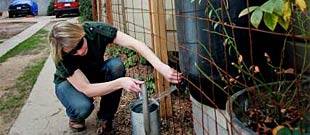
By Susan Carpenter
It started with gray water, then escalated to chickens, composting toilets and rain barrels. I'm talking about the two years I've spent transforming my humble California bungalow into a test case for sustainable living — an experience that's cost me hundreds of hours of my time and thousands of dollars, an endeavor that has tested the limits of not only my checkb ook but also my sanity — and my DIY skills.
When I launched the Realist Idealist column, the idea was to look at environmentally promising home improvement projects through the eyes of a budget-minded consumer. I had seen so much media coverage that heaped praise on newly constructed eco-manses or expensive retrofit products, but the stories didn't answer my biggest question: For the green-minded person writing the checks, are the improvements worth the time, effort and expense?
Although everything I retrofitted seemed wise at the time I did it, hindsight tells a different story. Over time, I occasionally questioned the wisdom of some actions.
The idealist in me finds value in every improvement, but the realist can't deny that some have been far better in terms of payback — if not financially, at least morally. The systems that easily fold in to my busy life are the ones I've enjoyed most.
What's been worth the money and effort, and what hasn't? I've divided the projects into two categories: "Worth It" and "Second Thoughts."
WORTH IT
Gray water, 1st place
Gray water is the waste generated from faucets, showers and laundry machines — water that accounts for 54.2% of all water used inside a home, according to the U.S. Environmental Protection Agency. With California deep into a drought, in August 2008 I retrofitted the plumbing on my laundry machine to send its gray water onto my landscape. Over the last two years, that simple switch has sent 9,720 gallons to passion fruit vines instead of the sewer, and it required only one change to my usual routine. I had to swap laundry detergents because my usual brand, like many, contained salt and other ingredients that kill plants.
When I first installed a gray-water system, it wasn't legal. Making it legal would have required a permit, extensive filtering apparatus and lots of cash. But in August 2009, these laundry-to-landscape systems were legalized in California, as long as homeowners followed 12 guidelines.
I've been so pleased with this low-cost, high-impact system that I hired a plumber to expand it in January, tying the wastewater from my bathtub, shower and bathroom sink into the same gravity-fed plumbing line that handles my laundry water. This so-called simple system also was legalized in California in 2009. Its legal status has since been rescinded, so once again I've gone rogue. I estimate my additional savings to be roughly 1,120 gallons per month.
Financially, this system is paying for itself, just slowly. The Los Angeles Department of Water and Power charges me less than half a penny per gallon, so technically, gray water has saved me only $95 in water costs so far. But it's also reduced my sewer charge by about one-third, saving me an extra $3.30 per month. In drought-prone Southern California, gray water feels like the right thing to do. It's been the easiest, most sensible, hassle-free, sustainable system I've put in place at my house.
Cost: $1,988 ($312 for the laundry-to-landscape plumbing, $1,676 for bathtub and bathroom sink tie-in)
Solar power, 2nd place
Photovoltaic systems pay off most quickly for consumers who use a lot of energy because tiered rates impose a penalty for heavy use, but solar electric still makes sense for low-energy users such as myself.
So much of Americans' carbon footprint results from buildings — about 43%, according to the U.S. Department of Energy. I'm a household of 1.5 (mom and 7-year-old), and we use only about 4 kilowatt hours of electricity per day, something we've managed through behavioral changes, such as turning off the lights in rooms after we've exited, and through in-home efficiencies, such as swapping out incandescent light bulbs for compact fluorescents and using power strips that can turn off DVD players, coffee makers and other energy vampires.
Using less electricity means I can get by with a smaller, less expensive photovoltaic system that not only covers my use but also produces a credit on my power bill. Going solar also meant my house was upgraded with a time-of-use meter. This type of meter allows me to receive credit for the electricity I generate during peak hours when electricity costs the most, but pay the least for the electricity during off-peak hours, when I recharge my cellphone and laptop and perform other tasks requiring power.
The downsides are that I am tied in to the grid and still susceptible to power outages, and I now have panels that need to be cleaned. It's a subject of debate, but my installer, REC Solar, said dirty panels decrease energy production by 6% to 8%. Many panel manufacturers recommend cleaning panels at least once during the summer. I wash mine whenever they look dirty or dotted with bird droppings, which is about every other week.
I think $6,000 is a small price to pay, not only for panels that should generate my next 20 years of electricity, but also for the greenhouse-gases I'm not creating.
Article courtesy of latimes.com

